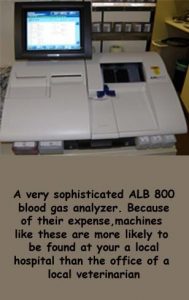Why Is My Dog Or Cat’s Blood pH High Or Low?
“High” and “low” can be quite confusing when dealing with pH. A higher number actually reflects a lower pH whereas a lower number reflects a higher pH. pH above 7 are basic or alkaline pH. pH below 7 are acidic pH. pH of 7.0 are neutral.
Ron Hines DVM PhD
 See What Normal Blood & Urine Values Are
See What Normal Blood & Urine Values Are
 Causes Of Most Abnormal Blood & Urine Tests
Causes Of Most Abnormal Blood & Urine Tests
The pH Of Your Pet’s Blood = The Acidity Level Of Your Dog Or Cat’s Blood
For a more thorough explanation of why your dog and cat’s blood pH reading could be low, see the causes of a high anion gap.
Your dog and cat’s bodies have complex buffering systems (to keep body acidity/alkalinity in a very narrow range). These systems rely on dissolved carbon dioxide, blood proteins, blood phosphates and the pet’s kidney abilities to eliminate hydrogen ions to tightly regulate the pH of its body.
Things like your pet’s body weight, WBC count and blood chemistry values can vary a bit in healthy pets; but anything other than tiny variations in your dog and cat’s blood pH are not compatible with life.
Your dog and cat’s blood is normally slightly on the alkaline side (a pH just above 7). When problems arise, they generally occur when the pet’s blood pH wanders below that (= acidosis). Should it rise, the situation is called alkalosis.
Reasons Why Your Dog Or Cat’s Blood Might Become Too Acidic (Acidosis, Low pH):
The two most common causes of acidosis in pets are pending kidney failure (causing metabolic acidosis) and unregulated diabetes in dogs and in cats (diabetic ketoacidosis).
Sustained diarrhea can also cause acidosis when too much base (high pH elements) are lost.
Failure of your pet’s circulatory system to keep its body well oxygenated (hypoxia, hypoperfusion), as occurs in shock, septic shock, severe blood loss or heart and lung failure can also cause a drop in blood pH.
Extremely strenuous exercise or prolonged seizures (lactic acidosis) is another cause of transient acidosis.
Blockage to the flow of urine (e.g. blocked cats with FUS, dogs with oxalate stone obstructions) also lowers blood pH.
Starvation or toxic compounds such as grain alcohol, methanol, antifreeze (ethylene glycol), aspirin or ibuprofen can also cause your dog or cat’s blood pH to go down.
Too rapid an administration of unbuffered IV saline solutions has also resulted in acidosis (low blood pH).
Reasons Why Your Dog Or Cat’s Blood pH Might Be Too High (i.e. too basic = alkalosis):
The most common cause is sustained vomiting. Persistent vomiting depletes stomach acid, which raises the body’s pH (alkalosis).
Excessive doses of diuretics (e.g. furosemide, hydrochlorothiazide, etc.) can also cause alkalosis (high pH) as can the high cortisol levels that occur in Cushing’s disease or in the overzealous use of corticosteroid medications.
Complementary Tests:
CBC/ WBC, blood chemistry panel, anion gap
DxMe
 Dear reader, Besides your donations, Visiting the products that you see displayed on this webpage also helps me pay the costs of keeping these articles on the Web. Best wishes, Ron Hines.
Dear reader, Besides your donations, Visiting the products that you see displayed on this webpage also helps me pay the costs of keeping these articles on the Web. Best wishes, Ron Hines.


